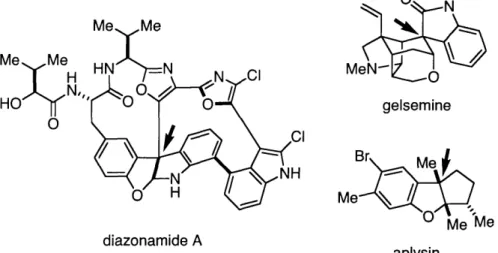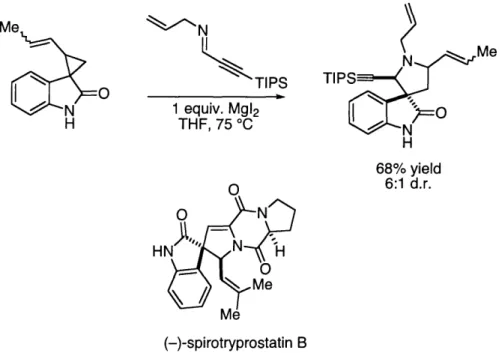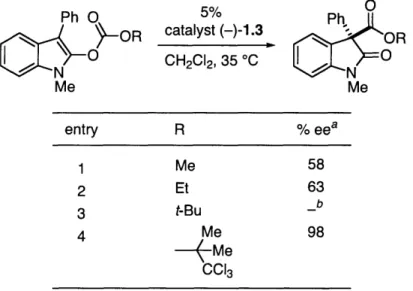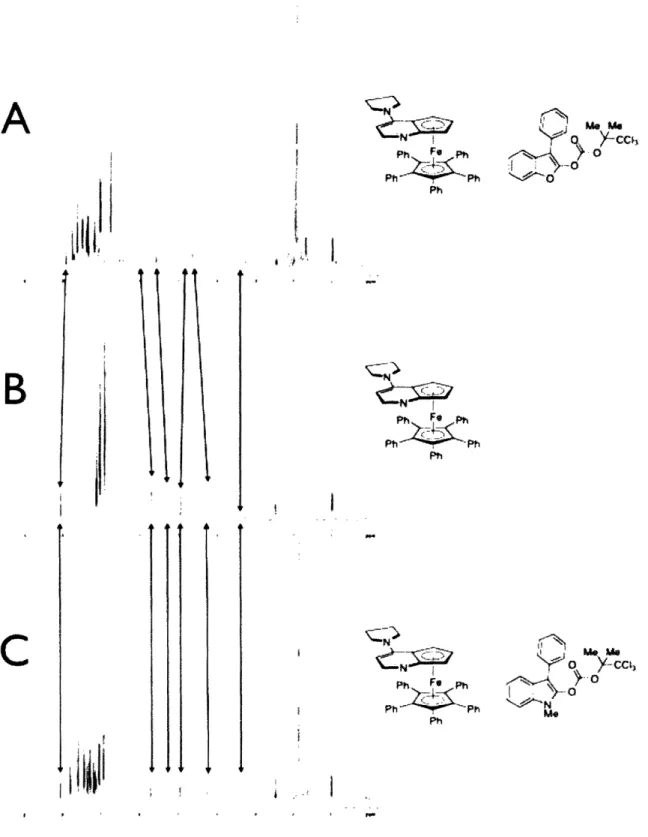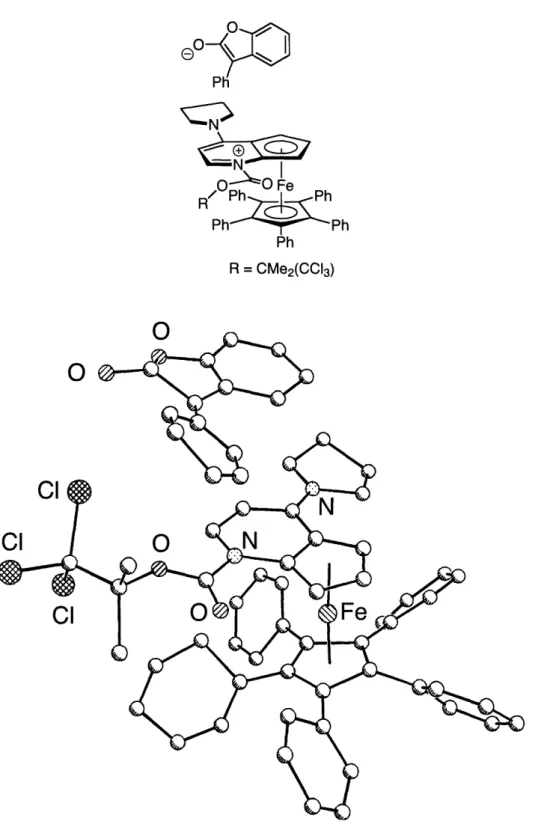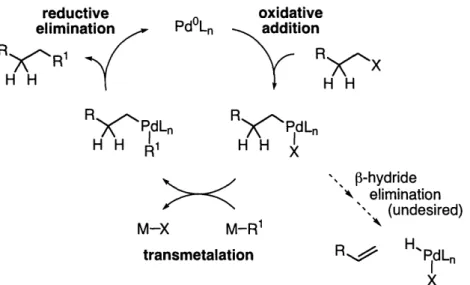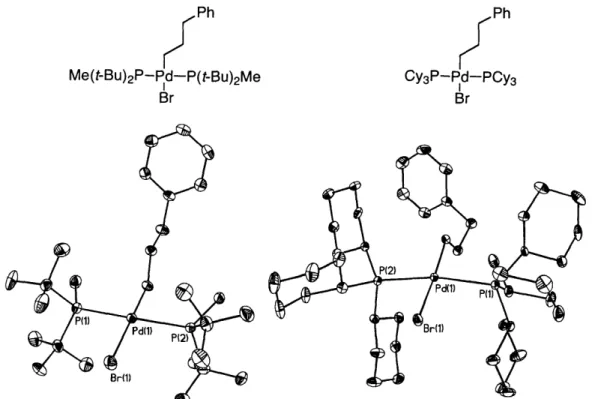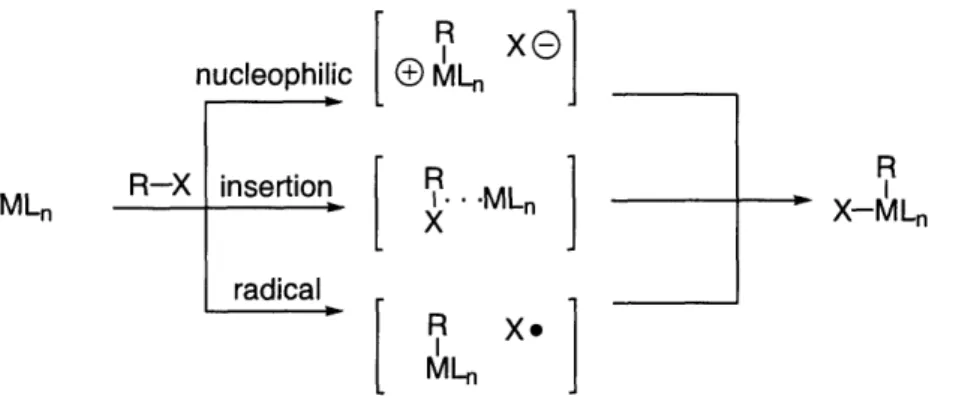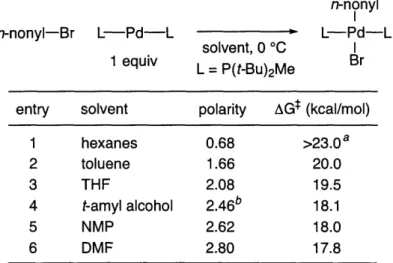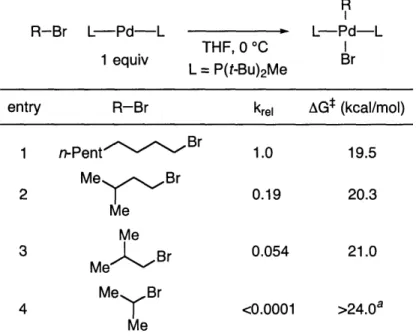Catalytic Enantioselective Synthesis of Oxindoles and Benzofuranones bearing a Quaternary Stereocenter
and
Reactions of Palladium Bisphosphine Complexes Relevant to Catalytic C-C Bond Formation
by
Ivory Derrick Hills B.S., Chemistry
University of North Carolina - Chapel Hill, 1999 Submitted to the Department of Chemistry
In Partial Fulfillment of the Requirements For the Degree of
DOCTOR OF PHILOSOPHY IN ORGANIC CHEMISTRY
at the
Massachusetts Institute of Technology August 2004
© 2004 Massachusetts Institute of Technology. All rights reserved.
Signature of Author Department of Chemistry August 12, 2004 Certified by 4 J Gregory C. Fu Thesis Supervisor Accepted by Robert W. Field Chairman, Departmental Committee on Graduate Studies
MASCUSTSN_!tT MASSACHUSETTS INSTITUTE OF TECHNOLOGY SEP 15 2004 ,.-- e- i -Wvov tu
-This doctoral thesis has been examined by a committee of the Department of Chemistry as follows:
(
Professor Stephen L. Buchwald
Chairman
Professor Gregory C. Fu
Thesis Supervisor
Professor Rick L. Danheiser
Catalytic Enantioselective Synthesis of Oxindoles and Benzofuranones bearing a Quaternary Stereocenter
and
Reactions of Palladium Bisphosphine Complexes Relevant to Catalytic C-C Bond Formation
by
Ivory D. Hills
Submitted to the Department of Chemistry on August 12, 2004 In Partial Fulfillment of the Requirements For the Degree of
Doctor of Philosophy in Organic Chemistry
ABSTRACT
In Part I the development of a new method for the construction of
oxindoles and benzofuranones bearing quaternary stereocenters is discussed. A planar-chiral PPY derivative catalyzes the O-to-C acyl group migration (Black rearrangement) in a highly efficient and enantioselective manner. The utility of this method is further demonstrated by the formal total synthesis of the natural product aplysin. R1 5% R1 ~_OR catalyst (-)-1 .3 i_ 't° CH2CI2, 35 °C . . R = CMe2(CCI3) X = 0, NR 2 88-99% ee 1 S-N I Ph Fe Ph _. Jn PHn -r- -n Ph (-)-1.3 " NI 1
In Part II reactivity of bisphosphine palladium-complexes is discussed. It is shown that the oxidative addition of bisphosphine palladium-complexes bearing P(t-Bu2)Me occurs through an SN2-type mechanism. This discovery
allows us rationalize the difference in catalytic activity between Pd(P(t-Bu2)Me)2
and Pd(P(t-Bu2)Et)2for the cross-coupling of alkyl electrophiles.
n-nonyl
SN2 I
n-nonyl-Br L Pd -L L-Pd-L
THF I
1 equiv L = P(t-Bu)2Me Br
AGt = 20.8 kcal/mol (20 °C); AHt= 2.4 kcal/mol; ASt = -63 eu * added phosphine does not affect the rate
Slower Reaction Faster Reaction
The reductive elimination of H-X from bisphosphine palladium-hydride complexes is also discussed. The discovery that (P(t-Bu)3)2PdHCl undergoes
facile reductive elimination in the presence of Cy2NMe, while (PCy3)2PdHCl does
not, is explained using X-ray crystal structures. These reactivity patterns may help to explain why Pd(P(t-Bu)3)2 is a much better catalyst than Pd(PCy3)2for the
Heck coupling of aryl chlorides.
Solvent Leaving Group Substrate Branching
Less Polar More Polar
Fluoride << Chloride < Tosylate < Bromide << Iodide a << fi < y < straight chain
This step can be kinetically slow and thermodynamically unfavorable! reductive base-H elimination base -,H LnPdsX R Ar ,-hydride elimination, olefin decomplexatior
a
x LXPd(O) LnPd(O) oxidative addition Ar-X Ar LnPd" X I R Ar \ LPd" H R X olefin complexation, 7I ~
olefin
insertion
Finally, Part III describes preliminary work on a palladium-hydride catalyzed isomerization of allylic alcohols as well as initial attempts to study the mechanism of nickel-catalyzed cross-couplings of secondary alkyl-electrophiles.
Portions of this document have appeared in the following publications:
Hills, I. D.; Fu, G. C. "Elucidating Reactivity Differences in Palladium-Catalyzed Processes: The Chemistry of Palladium Hydrides" J. Am. Chem. Soc. Accepted for publication.
Hills, I. D.; Netherton, M. R.; Fu, G. C. "Toward in Improved
Understanding of the Unusual Reactivity of Pd(0)/Trialkylphosphine Catalysts in Cross-Couplings of Alkyl Electrophiles: Quantifying the Factors That
Determine the Rate of Oxidative Addition" Angew. Chem. Int. Ed. 2003, 42, 5749-5752.
Hills, I. D.; Fu, G. C. "Catalytic Enantioselective Synthesis of Oxindoles and Benzofuranones that Bear a Quaternary Stereocenter" Angew. Chem. Int. Ed.
2003, 42, 3921-3924.
Kirchhoff, J. H.; Netherton, M. R.; Hills, I. D.; Fu, G. C. "Boronic Acids: New Coupling Partners in Room-Temperature Suzuki Reactions of Alkyl Bromides. Crystallographic Characterization of an Oxidative-Addition Adduct Generated Under Remarkably Mild Conditions" J. Am. Chem. Soc. 2002, 124, 13662-13663.
ACKNOWLEGMENTS
I have many people to thank for helping me get to this point in my life. First I would like to thank all of the great teachers I had in high school. I would also like to express my gratitude for Professors Joseph Templeton, Maurice Brookhart, and Lee Pedersen, mentors who showed me that research could be lots of fun. I would also like to mention the support that I've received from the MIT Organic Faculty. Specifically, I learned a tremendous amount as a first-year student in Prof. Barbara Imperiali's tutorial class and in Prof. Tim Jamison's advanced organic class. These two great teachers helped prepare me for the latter parts of my graduate career. I would also like to thank Profs. Steve Buchwald and Tim Swager for many encouraging words and enlightening discussions concerning my future. I consider myself fortunate to be in the midst of a faculty that is committed to both educating students and performing
excellent research.
Of course it would have been difficult to conduct any research without the support of a group. I've had many co-workers over the years and would like to mention, by name, some the excellent scientists I've had the privilege of working with: Dr. Craig Ruble, Dr. Michael Lo, Dr. Brian Hodous, Dr. Beata Tao, Dr. Shih-Yuan Liu, Dr. Matthew Netherton, Dr. Wayne Tang, Mr. Jianrong (Steve) Zhou, Mr. Jon Wilson and of course Professor Ryo Shintani.
I would also like to thank the group members who took time out of their busy schedules and help proofread this thesis: Jon, Wade, Steve, Kevin, Sheryl,
I've been lucky enough to have a supportive family, which helped me through the tough times. This used to be exclusively the Hills family, which consisted of my parents and brother. Then I got married and somehow it was extended to the Adams, Kopp, Rosso, and Schultz families. All of these people have been tremendously caring over the years and they have my everlasting gratitude.
I've made some great friends in graduate school, including Johann, Ryo, Martin and Liu. I'm grateful that we've been able to help each other through the tough times. We've also had the opportunity to share many happy moments, and I expect the future to hold more of the same.
Finally, I should mention my advisor, Prof. Greg Fu, and my wife, Chrissy Kopp, the two most important people in helping me to get to this point in my life. Greg has helped me in immeasurable ways, simply by expecting me to do my best. He's the best role model I could have, and I'm eternally grateful for his guidance. Chrissy has also been supportive in more ways than I can describe here; however, I should mention she's been a great friend by encouraging me when my advisor was pushing me to do my best, which can be rather stressful to say the least. Thanks to both of you.
TABLE OF CONTENTS
Abbreviations
Part I Enantioselective Synthesis Catalyzed by a Planar-Chiral Heterocycle
Chapter 1 Synthesis of Oxindoles and Benzofuranones Bearing a Quaternary Stereocenter
A. Introduction
B. Results and Discussion C. Conclusions
D. Experimental
Part II Reactions of Palladium Bisphosphine Complexes Relevant to Catalytic C-C Bond Formation
Chapter 2 Oxidative Addition of Alkyl Electrophiles to Palladium Bisphosphine Complexes
A. Introduction
B. Results and Discussion C. Conclusions
D. Experimental
Chapter 3 Reductive Elimination of H-X from Palladium Hydrides
12 16 22 31 32 72 78 87 88
C. Conclusions D. Experimental
Part III
Chapter 4
Miscellaneous
Palladium-Hydride Catalyzed Isomerizations of Allylic Alcohols
A. Introduction
B. Results and Discussion C. Conclusion
D. Experimental
Chapter 5 Mechanistic Investigations of Nickel-Catalyzed Cross-Couplings of Secondary Alkyl Electrophiles
A. Introduction
B. Results and Discussion C. Conclusion
D. Experimental
Curriculum Vitae
Appendix A X-ray Crystal Structure Data Appendix B Selected H NMR Spectra
131 132 155 158 163 164 171 177 183 184 188 189 346
Abbreviations BP bathophenantroline bpy 2,2'-bipyridine cod cyclooctadiene DMA N,N-dimethylacetamide DMAP 4-(dimethylamine)pyridine DMF N,N-dimethylformamide DMSO dimethylsulfoxide eq equation equiv equivalent(s) GC gas chromatography
HPLC high performance liquid chromatography
HRMS high resolution mass spectrometry
PPY 4-pyrrolidinopyridine
r.t. room temperature
Part I
Enantioselective Synthesis Catalyzed by a Planar-Chiral
Heterocycle
Chapter 1
Synthesis of Oxindoles and Benzofuranones Bearing a Quaternary
Stereocenter
A. Introduction
Heterocycles represent a vitally important class of molecules, which manifest themselves in both natural products and synthetic molecules with therapeutic properties.' In particular, molecules derived from aromatic-fused heterocycles such as oxindoles and benzofuranones have proven to be popular synthetic targets due to their interesting structure and biological activity.2
Several of these natural products bear quaternary stereocenters, such as diazonamide A,3 4gelsemine,5 and aplysin6 (Figure 1.1). Recent advances have
been made in the development of methods capable of constructing these
stereocenters. 7,8'9
1 For reviews on the synthesis of natural and unnatural heterocycles and their biological
relevance, see: (a) Deiters, A.; Martin, S. F. Chem. Rev. 2004, 104, 2199-2238. (b) Wijtmans, R.;
Vink, M. K. S.; Schoemaker, H. E.; Van Delft, F. L.; Blaauw, R. H.; Rutjes, F. P. J. T. Synthesis 2004,
641-662. (c) Royer, J.; Bonin, M.; Micouin, L. Chem. Rev. 2004, 104, 2311-2352. (d) Firstner, A.
Angew. Chem. Int. Ed. 2003, 42, 3582-3603.
2 For reviews on recent syntheses of oxindole-derived natural products, see: (a) Lin, H.;
Danishefsky, S. J. Angew. Chem. Int. Ed. 2003, 42, 36-51. (b) Green, L.; Chauder, B.; Snieckus, V. J.
Heterocycl. Chem. 1999, 36, 1453-1468. (c) Brossi, A.; Pei, X.-F.; Greig, N. H. Aust. J. Chem. 1996, 49,
171-181.
3 The structure of diazonamide A has undergone revision. For details, see: (a) Ritter, T.; Carreira, E. M. Angew. Chem. Int. Ed. 2002, 41, 2489-2495. (b) Li, J.; Jeong, S.; Esser, L.; Harran, P. G. Angew.
Chem. Int. Ed. 2001, 40, 4765-4769. (c) Li, J.; Burgett, A. W. G.; Esser, L.; Amezcua, C.; Harran, P. G. Angew. Chem. Int. Ed. 2001, 40, 4770-4773.
4 For total syntheses of diazonamide A, see: (a) Burgett, A. W. G.; Li, Q.; Wei, Q.; Harran, P. G.
Angew. Chem. Int. Ed. 2003, 42, 4961-4966. (b) Nicolaou, K. C.; Rao, P. B.; Hao, J.; Reddy, M. V.;
Rassias, G.; Huang, X.; Chen, D. Y.-K.; Snyder, S. A. Angew. Chem. Int. Ed. 2003, 42, 1753-1758. (c) Nicolaou, K. C.; Bella, M.; Chen. D. Y.-K.; Huang, X.; Ling, T.; Snyder, S. A. Angew. Chem. Int. Ed.
2002, 41, 3495-3499.
5 For total syntheses of gelsemine, see: (a) Ng, F. W.; Lin, H.; Danishefsky, S. J. J. Am. Chem. Soc. 2002, 124, 9812-9824. (b) Yokoshima, S.; Tokuyama, H.; Fukuyama, T. Angew. Chem. Int. Ed. 2000,
39, 4073-4075. (c) Madin, A.; O'Donnell, C. J.; Oh, T.; Old, D. W.; Overman, L. E.; Sharpe, M. J.
Angew. Chem. Int. Ed. 1999, 38, 2934-2936. (d) Fukuyama, T.; Liu, G. J. Am. Chem. Soc. 1996, 118,
7426-7427. (e) Newcombe, N. J.; Ya, F.; Vijn, R. J.; Hiemstra, H.; Speckamp, W. N. J. Chem. Soc.,
Chem. Commun. 1994, 767-768.
6 For the most recent synthesis of aplysin, see: Srikrishna, A.; Babu, N. C. Tetrahedron Lett. 2001,
42, 4913-4914. For an overview of the aplysin family of natural products, see: Harrowven, D. C.;
Lucas, M. C.; Howes, P. D. Tetrahedron 2001, 57, 791-804, and references therein.
- H Me HO MeN-gelsemine Br I Me_l 0 Me diazonamide A aplysin
Figure 1.1. Oxindole- and benzofuranone-derived natural products bearing quaternary stereocenters.
Overman and co-workers have developed an intramolecular
enantioselective Heck reaction, and have successfully applied this method to natural product synthesis (Figure 1.2).7 Thus, an aryl iodide can undergo a palladium-catalyzed Heck cyclization to furnish an oxindole core bearing a quaternary stereocenter, which can be further elaborated to either physovenine or physostigmine.
9 For reviews on the catalytic enantioselective construction of quaternary centers, see: (a) Douglas, C. J.; Overman, L. E. Proc. Natl. Acad. Sci. U.S.A. 2004, 101, 5363-5367. (b) Christoffers, J.; Baro, A.
10% Pd2(dba)3'CHCI3 Me OTIPS 23% (S)-BINAP Meo O 1,2,2,6,6-pentamethylpiperidine N DMA, 1000C Me 95% ee Me ~~~~~Me MeNHC0 2 MeNHCO2 Me
K",,N
H
,
N H
Me Me (-)-physovenine (-)-physostigmineFigure 1.2. Use of an enantioselective Heck reaction by Overman and co-workers
to synthesize a key intermediate in the synthesis of physovenine and physostigmine.
Another interesting example of the construction of a quaternary stereocenter on a heterocyclic core is the catalytic diastereoselective
ring-expansion protocol developed by Carreira and co-workers.8 The MgI2-catalyzed
diastereoselective ring expansion between a spiro[cyclopropane-1,3'-oxindole] and an aldimine furnishes a spiro[oxindole-3,3'-pyrrolidine] (Figure 1.3). Carreira has shown that subsequent coupling with a proline derivative allows resolution of the enantiomers, and ultimately the synthesis of
(-)-spirotryprostatin B.
<-N
TIPS 1 equiv, Mg12 THF, 75 °C N M e TIPS-N H 68% yield 6:1 d.r. (-)-spirotryprostatin BFigure 1.3. Use of a diastereoselective ring-expansion strategy by Carreira and
co-workers to synthesize a key intermediate in the synthesis of spirotryprostatin
B.
The methods of Overman and Carreira are examples of methods capable of the synthesis of quaternary stereocenters on an oxindole framework; °
however, in general, efficient catalytic enantioselective synthesis of these stereocenters remains a challenge in organic chemistry.
In 1986 Black reported that 4-dimethylaminopyridine (DMAP)n catalyzes
the rearrangement of O-acylated benzofuranones to their C-acylated isomers (eq 1.1).2 Although this method furnishes racemic products, the transformation is excellent for the efficient assembly of quaternary stereocenters on this
10 For other examples, see: (a) Lee, S.; Hartwig, J. F. J. Org. Chem. 2001, 66, 3402-3415. (b) Onishi,
T.; Sebahar, P. R.; Williams, R. M. Org. Lett. 2003, 5, 3135-3137.
1n For examples of applications of DMAP in organic synthesis, see: (a) Murugan, R.; Scriven, E. F.
V. Aldrichimica Acta 2003, 36, 21-27. (b) Hoefle, G.; Steglich, W. Synthesis 1972, 619-621.
12 (a) Black, T. H.; Arrivo, S. M.; Schumm, J. S.; Knobeloch, J. M. J. Org. Chem. 1987, 52, 5425-5430.
(b) Black, T. H.; Arrivo, S. M.; Schumm, J. S.; Knobeloch, J. M. J. Chem. Soc., Chem. Commun. 1986,
H
heterocyclic core,3which is confirmed by attempts to develop diastereoselective versions for use in complex natural product synthesis. For example, in studies directed toward the synthesis of the incorrect structure initially assigned to diazonamide A, Vedejs performed a diastereoselective rearrangement employing DMAP and a chiral auxiliary (eq 1.2).'4 Although an advance in the formation of this key stereocenter, only relatively low levels of diastereoselectivity could be achieved (d.r. = 3:1). Clearly an efficient catalytic enantioselective variant of the Black rearrangement would have synthetic utility.
Black Rearrangment Ph O Y-OR -~0 DMAP CH2CI2 r.t. R = Me, Et, n-Pr, n-Bu, sec-Bu
Bn, Ph, Allyl, Vinyl MeO2C NHTroc / Br OMe R*O DMAP THF r.t. 0 Ph OR 0 (1.1) 64% - 96% yield MeO2C NHTroc · CO2R* 0 3 : 1 diastereoselectivity Ph R*=
In recent years, our group has been interested in the development of methods employing a family of planar-chiral derivatives of DMAP and PPY
(PPY = 4-(pyrrolidino)pyridine; e.g., 1.1-1.4).56 In the context of enantioselective C-C bond formation through acylation, we have explored the rearrangement of
O-acylated azlactones1 7 and the acylation of latent enolates (e.g., silyl ketene
acetals'8 and silyl ketene imines19). In view of the potential significance of the reaction products, we decided to explore the use of the planar-chiral catalysts in an asymmetric variant of the Black rearrangement of O-acylated oxindoles and benzofuranones.2 0 Me.N*Me R Fe R
R
R
R DMAP-derived R = Ph: (-)-1.1 Me: (-)-1.2 N N R Fe RR
R
R PPY-derived R = Ph: (-)-1.3 Me: (-)-1.415 For an overview, see: (a) Fu, G. C. Acc. Chem. Res. 2004, ASAP. (b) Fu, G. C. Acc. Chem. Res. 2000, 33, 412-420.
16 For examples of other chiral DMAP derivatives, see: Spivey, A. C.; Maddaford, A.; Redgrave,
A. . Org. Prep. Proced. Int. 2000, 32, 333-365.
17 Ruble, J. C.; Fu, G. C. J. Am. Chem. Soc. 1998, 120, 11532-11533. 8
Mermerian, A. H.; Fu, G. C. J. Am. Chem. Soc. 2003, 125, 4050-4051. 19 Mermerian, A. H.; Fu, G. C. Manuscript in preparation.
20 Vedejs has studied the catalytic enantioselective rearrangement of O-acylated azlactones,
B. Results and Discussion
An early study of the catalytic enantioselective rearrangement of 0-acylated benzofuranones gave modest results (eq 1.3),21 but, we were optimistic that further optimization was possible. Due to the greater prevalence and
importance of oxindole-derived products in the literature, we turned our focus to optimizing the rearrangement of -acylated oxindoles to furnish their C-acylated isomers. N Ph '0-O 10% (+)-1.2
60_~~
THF-d8, r.t. 0 2 days (1.3) 56% eeInitial screens of catalyst, solvent, and temperature established a system capable of rearranging O-acylated oxindoles with modest levels of
enantioselectivity (eq 1.4). 0
PhO~~~
Ph Me % (-)-1.3 PYO~~~~e
M
e (1.4)
0 $ 0 CH2C12, 350 °(C N 24 .h N Me Me 58% eeWe reasoned that the bulk of the rearranged acyl group might have an influence on the outcome of the reaction. Thus, we synthesized derivatives of our model substrate and tested them under our standard conditions (Table 1.1).
We were gratified to discover that, upon increasing the steric bulk of the acyl group (Me Et), an increase in enantioselectivities could be realized (entries 1 and 2, 58-63% ee). Unfortunately, attempts to achieve an additional increase in ee by using a t-butyl group were stymied by a lack of reactivity (entry 3). We believed that the reactivity of the substrate could be improved by enhancing the electrophilicity of the acyl group; therefore, we employed an electron deficient t-butyl analogue, a 2,2,2-trichloro-1,1-dimethylethyl (trichloro-t-t-butyl) group.' Use of the trichloro-t-butyl group allowed access to the 3,3-disubstituted oxindole with an excellent level of enantioselectivity (entry 4, 98% ee).
Table 1.1. Effect of the acyl group rearrangements.
on the enantioselectivity of O-to-C
Ph O MES SOR Me 5% catalyst (-)-1.3 CH2CI2, 35 °C
o
Ph. N OR 0 Me entry R %eea 1 Me 58 2 Et 63 3 t-Bu b 4 Me 98-- Me
CC13a The data are an average of two runs.
b No rearrangement was observed.
With these conditions established, we next examined the scope of this rearrangement. Employing the trichloro-t-butoxycarbonyl substituent as the 22 2,2,2-Trichloro-1,1-dimethyl chloroformate is commercially available. The trichloro-tert-butoxycarbonyl group has been employed in kinetic resolutions of secondary alcohols by an N-acylated chiral derivative of DMAP. For details, see: Vedejs, E.; Chen, X. J. Am. Chem. Soc. 1996,
migrating group, catalyst 1.3 can effect highly enantioselective rearrangements for a diverse array of substrates (Table 1.2).2324 The reaction proceeds well with' either an aromatic or heteroaromatic group in the 3-position (entries 1 and 2). Alkyl substitutents, such as benzyl and methyl, require higher catalyst loading due to a slower rate of reaction; however, the desired products can still be obtained in excellent ee with good yields (entries 3 and 4). Remote substituents, such as a 5-iodo group, have no negative impact on the outcome of the reaction
(entry 5). Finally, use of an N-benzyl group gives results comparable to those obtained with an N-methyl group (compare entries 1 and 6).
Table 1.2. Catalytic enantioselective rearrangement of oxindole derivatives.
(' R1 "' -R
OR
R3
OR
,\ R~2 , , - ,..,,,.;,~v.,L5entry R1 R2 R3 % eea isolated yield (%)a
1 Ph Me H 99 91 2 2-thienyl Me H 95 81 3b benzyl Me H 94 82 4b Me Me H 93 72 5 Ph Me I 98 94 6 Ph Bn H 98 88
a The data are an average of two runs. b10% catalyst was used.
We next chose to determine if our optimized conditions for the rearrangement of O-acylated oxindoles could be extended to O-acylated
benzofuranones. We were pleased to discover that our standard conditions can furnish highly enantio-enriched benzofuranones bearing quaternary
stereocenters (Table 1.3). Aromatic-substituted substrates (entry 1) furnish products with excellent ee, while alkyl substituents also provide satisfactory results (entries 2 and 3).
Table 1.3. Catalytic enantioselective rearrangements of benzofuranone
derivatives. 5% catalyst (-)-1.3 CH2CI2, 35 °C 12 R = CMe2(CCI3)
entry R1 R2 % ee isolated yield (%)
1 Ph H 97 81
2 Bn H 88 95
3a Me Me 90 93
a This reaction was run at -12 °C with 10% catalyst.
Of particular interest is the 3,6-dimethyl-substituted benzofuranone (Table 1.3, entry 3). We have used a racemic mixture of the benzofuranone product to complete an unoptimized formal total synthesis of aplysin (Scheme 1.1). Thus, benzofuranone 1.5 undergoes olefination with Petasis' reagent2 5to furnish enol
ether 1.6.26 Subsequent reduction of the remaining ester with LiAlH4furnishes primary alcohol 1.7 in excellent yield, which can then be transformed to the alkyl
25 For examples of the olefination of esters with titanium reagents, see: Hartley, R. C.; McKiernan,
G. J. J. Chem. Soc., Perkin Trans. 1 2002, 2763-2793.
26 Olefination of 1.5 proceeds with only modest selectivity, and after initial workup a 78:22 mixture of mono-olefinated 1.6 and di-olefinated product is obtained in 54% yield. After additional purification by silica chromatography, 1.6 can be isolated in 32% yield. See
)R
iodide, 1.8, using PPh3, I2, and imidazole.2 72 8' Finally, metal-halogen exchange29
followed by quenching with allyl bromide furnishes butenyl-substituted benzofuranone, 1.9, which has been demonstrated to be a competent intermediate in the synthesis of aplysin.30
o
Me o OR0
Me 1.5 Me Me CH2 1.8 23% Cp2TiMe2 toluene 60 °C R = CMe2(CCI3) PPh3, 12, imidazole toluene 80 °C M t-BuLi allyl bromide Et20 -7R - oC 3 steps H2 -1.9 61%Scheme 1.1. Outline of a formal synthesis of ()aplysin.
27 For examples of the formation of alkyl iodides from sterically encumbered primary alcohols,
see: (a) Lange, G. L.; Gottardo, C.; Merica, A. J. Org. Chem. 1999, 64, 6738-6744. (b) Rydon, H. H.
Org. Synth. 1971, 51, 44-47.
2 8
The iodination of 1.7 occurs with unusually low yield. This may be due, in part, to the presence 1.6 32% LiAIH4 Et20 r.t. 1.7 93% 3H2 .
While developing rearrangement reactions catalyzed by 1.3, we monitored a remarkable color change in the reaction mixture when we employed
0-acylated benzofuranones as substrates.3 During initial studies on the
non-asymmetric variant of this rearrangement, Black also observed an unusual
change in reaction color; upon combination of a colorless solution of DMAP with a colorless solution of O-acylated benzofuranone, the mixture became a deep-blue color, which persisted for the duration of the reaction.32 Black postulated
that the rearrangement occurs through the mechanism illustrated in Scheme 1.2,33
and that an intermediate ion-pair, 1.10, was responsible for the deep-blue color; however, he did not provide spectroscopic evidence for this intermediate.?4
AN R R OR Me2N X ¢o 0 colorless I colorless
Icolorless
0 R ( -OR Me2N 1.10 deep blue]Scheme 1.2. Proposed mechanism for DMAP-catalyzed rearrangements of
0-acylated benzofuranones.
31 The catalyst 1.3 is a red-purple color when dissolved in CH2Cl2, but when combined with an
O-acylated benzofuranone the color rapidly changes to deep green.
32
Black, T. H.; Arrivo, S. M.; Schumm, J. S.; Knobeloch, J. M. J. Org. Chem. 1987, 52, 5425-5430.
33 This mechanism is consistent with typical pathways proposed for catalysis by nitrogen-based
nucleophiles. For further discussions, see: Eboka, C. J.; Connors, K. A. J. Pharm. Sci. 1983, 72,
366-369.
34 For additional examples of colored ion-pair charge-transfer complexes involving pyridinium,
We reasoned that it is likely that our planar-chiral nucleophilic catalyst promotes the rearrangement of O-acylated benzofuranones through a path similar to that outlined in Scheme 1.2. Thus, we postulated that the change in reaction color from red-purple (catalyst in the absence of substrate) to deep green (catalyst in the presence of substrate) is a result of the formation of an
intermediate ion-pair (the N-acylated catalyst and an enolate). We are able to support this hypothesis with experiments that show a shift in the 1H NMR
resonances of 1.3 when the complex is combined with O-acylated benzofuranone, which is consistent with the ion-pair being the resting state of the catalytic cycle (Figure 1.4, A and B). However, in contrast to this result, rearrangements of 0-acylated oxindoles catalyzed by 1.3 do not occur with a color change, and the H NMR spectrum of this combination do not show any significant changes in the shifts associated with 1.3, which is consistent with free catalyst and substrate being the resting state of this system (Figure 1.4, B and C). In addition to the H NMR data, we have been able to acquire a low-resolution X-ray crystal structure of the ion pair implicated in our catalytic cycle (Figure 1.5). These data are consistent with the 1.3-catalyzed rearrangement of -acylated benzofuranones occurring through a mechanism similar to that proposed by Black (Scheme 1.2).
A
Ph Fe F Ph Ph~Ph PhNoI
Ph F phPhPh
Ph I'll0
Y z e \ -'Figure 1.4. H NMR spectra of A: catalyst + O-acylated benzofuranone; B: free
catalys; C: catalyst + O-acylated oxindole.
L
i11,
I Ph mh PB
C
iJLfi Ip111' ,1, "'fo, x7m, 4" ""a : \', - ,0 1 0,-O
I I I .. I . 4 " I j , Il I l I P i i I . . i i .0eo-Ph No N Rz ~ Ph' Ph Ph R = CMe2(CCI3) C'
0
CI CI0
CIFigure 1.5. X-ray crystal structure of an ion pair derived from catalyst 1.3 and an
C. Conclusions
We have described the development of a catalytic enantioselective
rearrangement of O-acylated oxindoles and benzofuranones to their C-acylated isomers (Black rearrangement). This transformation proceeds in both good enantioselectivities and yields for aryl, heteroaryl, and alkyl substituents, furnishing 3,3-disubstituted oxindoles and benzofuranones, which may be valuable intermediates in natural product synthesis (eq 1.5). The utility of these products has been demonstrated by conducting a formal total synthesis of aplysin. We have also gathered evidence (reaction color, H NMR, X-ray crystallography) that suggests this transformation takes place through an N-acylated catalyst intermediate, similar to that proposed by Black. In view of the importance of oxindoles and benzofuranones bearing a quaternary stereocenter in the 3-position, we believe that this method may provide a powerful tool for asymmetric synthesis.
R1 0 5% R1 0
, F >\OR catalyst (-)-1.3 OR (1.5)
W '°0 CH2CI2, 35 C ° C
R = CMe2(CCI3) X = 0, NR2 88- 99% ee
R1 = aryl, heteroaryl, alkyl 72 -95% yield
R= Me, benzyl N N Ph Fe Ph Ph Ph Ph (-)-1 .3
D. Experimental
I. General
All reactions were carried out under an atmosphere of nitrogen or argon in oven-dried glassware with magnetic stirring, unless otherwise indicated. THF and CH2C12were purified by passage through a neutral alumina column.
All other reagents were used as received from commercial sources: NEt3(EM
Science), methyl chloroformate (Aldrich), ethyl chloroformate (Avocado), di-tert-butyl dicarbonate (Avocado), 2,2,2-trichloro-1,1-dimethylethyl chloroformate (Aldrich), NaH (Aldrich), isatin (Avocado), N-methylisatin (Avocado), 5-iodoisatin (Alfa), MeMgCl (Aldrich), PhMgBr (Aldrich), benzylmagnesium chloride (Aldrich), thiophen-2-yl-magnesium bromide (Aldrich), benzyl bromide (Alfa Aesar), SnCl2 (Alfa), and DMF (Aldrich). Cp2TiMe2was prepared
according to a known procedure.3 5
Catalyst (-)-1.3,36 3-phenyl-3H-benzofuran-2-one, 37
3-benzyl-3H-benzofuran-2-one,38 and 3,6-dimethyl-3H-benzofuran-2-one39 were prepared by literature methods.
35 Payack, J. F.; Hughes, D. L.; Cai, D.; Cottrell, I. F.; Verhoeven, T. R. Org. Prep. Proced. Int. 1995,
27, 707-709.
II. Synthesis of Oxindoles
The yields have not been optimized.
Ph 0° Me
General Procedure. 1-Methyl-3-phenyl-1,3-dihydro-indol-2-one. A flask containing N-methylisatin (1.0 equiv, 3.0 g, 19 mmol) was sealed with a septum
and flushed with argon. THF (80 mL) was added to give a 0.24 M solution, which was then cooled to -78 °C. Next, PhMgBr (3.0 M solution in Et2O; 1.1
equiv, 6.8 mL, 20 mmol) was added to the reaction mixture, which was stirred at -78 °C for 1 h and then warmed to room temperature and stirred for 24 h. The
reaction was quenched with aq NH4C1, and the product was extracted with
CH2C12. The organic layer was washed with aq NaCl, dried with MgSO4, and
then concentrated to afford a yellow oil.
The oil was dissolved in 90 mL of AcOH/HCl (15/1), and then SnC12 (2 equiv, 7.1 g, 37 mmol) was added. The reaction mixture was stirred at 80 °C for 90 min and then cooled to room temperature and diluted with water. The product was extracted with Et2O. The organic layer was washed with aq NaOH, dried with
MgSO4, and then concentrated to afford a fluffy yellow solid. Purification by
column chromatography (70% hexanes/30% Et2O) furnished a pale-yellow solid
in 29% overall yield (1.20 g).
CAS registry number: 3335-97-5. 1H NMR (500 MHz, CDC13) 5 3.26 (s, 3H), 4.62
7.21 (d, 2H, J = 7.5 Hz), 7.29 (m, 1H), 7.34 (m, 3H). 13C NMR (500 MHz, CDC13)
26.6, 52.2, 108.3, 122.9, 125.2, 127.7, 128.59, 128.60, 129.00, 129.04, 136.8, 144.7, 176.1.
0
Me
1-Methyl-3-thiophen-2-yl-1,3-dihydro-indol-2-one. The general procedure was
followed: N-methylisatin (2.0 g, 12 mmol), thiophen-2-yl-magnesium bromide (1.0 M in THF; 14 mL, 14 mmol), 65 mL of AcOH/HCl (15/1), and SnC12 (4.6 g, 24 mmol). The product was purified by column chromatography (80%
hexanes/20% Et2O), which furnished a yellow oil in 62% yield (1.76 g).
1H NMR (500 MHz, CDC13) 6 3.24 (s, 3H), 4.85 (s, 1H), 6.90 (d, 1H, J = 7.5 Hz),
6.99 (m, 1H), 7.03 (m, 1H), 7.11 (t, 1H, J = 7.5 Hz), 7.23 (d, 1H, J = 5.0 Hz), 7.35 (d,
2H, J = 8.0 Hz). 13C NMR (500 MHz, CDC13) 6 26.6, 47.0, 108.4, 122.8, 125.1, 125.2,
126.0, 127.0, 128.0, 128.8, 137.9, 144.1, 174.6. FTIR (thin film) 1715, 1612, 1493, 1469, 1345, 1086 cm'. HRMS (ESI) calcd for C13HnNNaOS (M+Na+) 252.0454,
Ph
0O
1-Methyl-3-benzyl-1,3-dihydro-indol-2-one. The general procedure was
followed: N-methylisatin (3.0 g, 19 mmol), benzylmagnesium chloride (2.0 M in THF; 10 mL, 20 mmol), 90 mL of AcOH/HCl (15/1), and SnCl2 (7.1 g, 37 mmol).
The product was purified by column chromatography (80% hexanes
/
20% Et2O),which furnished a pale-yellow solid in 34% yield (1.55 g).
CAS registry number: 3335-85-1. 1H NMR (500 MHz, CDCl3) 6 2.86 (dd, 1H, J =
13.5, 9.5 Hz), 3.11 (s, 3H), 3.49 (dd, 1H, J = 13.5, 4.5 Hz), 3.67 (dd, 1H, J = 9.0, 4.5 Hz), 6.73 (dd, 2H, J = 11.5, 8.0 Hz), 6.90 (t, 1H, J = 7.5 Hz), 7.15 (d, 2H, J 8.0 Hz), 7.21 (m, 4H). 13C NMR (500 MHz, CDCl3) 6 26.0, 36.7, 46.9, 107.8, 121.9, 124.4, 126.5, 127.9, 128.19, 128.23, 129.3, 137.9, 144.1, 176.8. Me
0
Me1,3-Dimethyl-1,3-dihydro-indol-2-one. The general procedure was followed:
N-methylisatin (2.5 g, 16 mmol), MeMgCl (3.0 M in THF; 5.7 mL, 17 mmol), 60 mL of AcOH/HCl (15/1), and SnCl2 (4.4 g, 23 mmol). The product was purified by
column chromatography (80% hexanes
/
20% Et2O), which furnished a yellow oilin 53% yield (1.31 g).
CAS registry number: 24438-17-3. 1H NMR (500 MHz, CDC13) 1.46 (d, 3H, J = 7.5 Hz), 3.18 (s, 3H), 3.40 (q, 1H, J = 7.5 Hz), 6.81 (d, 1H, J = 7.5 Hz), 7.04 (t, 1H, J = 7.0 Hz), 7.22 (d, 1H, J = 7.0 Hz), 7.26 (t, 1H, J = 8.0 Hz). 13C NMR (500 MHz, CDC13) 5 15.4, 26.2, 40.6, 108.0, 122.4, 123.5, 127.9, 130.7, 144.0, 178.7. Ph 0 Me
1-Methyl-3-phenyl-5-iodo-1,3-dihydro-indol-2-one. The general procedure was
followed: N-methyl-5-iodoisatin (2.0 g, 7.0 mmol), PhMgBr (1.0 M in THF; 8.4 mL, 8.4 mmol), 35 mL of AcOH/HCl (15/1), and SnCl2(2.7 g, 14 mmol). The
reaction mixture was cooled, and the desired product crystallized from the mixture. The isolated crystals were washed with Et2O to furnish a white solid in
58% yield (1.45 g).
1H NMR (500 MHz, CDC13) 5 3.24 (s, 3H), 4.60 (s, 1H), 6.69 (d, 1H, J = 8.0 Hz),
7.19 (d, 2H, J = 7.5 Hz), 7.34 (m, 3H), 7.45 (s, 1H), 7.65 (d, 1H, J = 7.5 Hz). 13C NMR (500 MHz, CDC13)
8
26.6, 51.9, 85.3, 110.3, 127.9, 128.5, 129.1, 131.3, 133.7,136.0, 137.4, 144.3, 175.3. FTIR (thin film) 1700, 1597, 1488, 1338, 1098 cm'l. mp 180-183 °C.HRMS (ESI) calcd for C15H12INO (M+H+) 350.0036, found 350.0031.
0
0
N
Bn
N-Benzylisatin. In a glovebox, NaH (590 mg, 24 mmol) was added to a solution
of isatin (3.0 g, 20 mmol) in DMF (40 mL). The reaction mixture was stirred at room temperature for 30 min, and then the flask was sealed with a septum and removed from the glovebox. Benzyl bromide (4.2 g, 24 mmol) was added, and the reaction mixture was stirred at room temperature for 20 h. The reaction was then quenched by careful addition of water, and the product was extracted into Et2O. The organic layer was washed with aq NaCl, dried with Na2SO4, and
concentrated, yielding 4.5 g of an orange crystalline solid (92% yield).
CAS registry number: 1217-89-6. 1H NMR (500 MHz, CDC13) 4.95 (s, 2H), 6.78
(d, 1H, J = 8.0 Hz), 7.10 (t, 1H, J = 7.3 Hz), 7.35 (m, 5H), 7.49 (dt, 1H, J = 8.0, 1.5 Hz), 7.63 (dd, 1H, J = 7.5, 1.4 Hz).
Ph
N
Bn
1-Benzyl-3-phenyl-1,3-dihydro-indol-2-one. The general procedure was
followed: N-benzylisatin (2.5 g, 11 mmol), PhMgBr (1.0 M in THF; 13 mL, 13 mmol), 70 mL of AcOH/HCl (15/1), and SnCl2 (4.0 g, 21 mmol). The product
was purified by column chromatography (80% hexanes/20% Et2O), which
CAS registry number: 3335-95-3. 1H NMR (500 MHz, CDC13) 8 4.78 (s, 1H), 4.96 (d, 1H, J = 15.6 Hz), 5.08 (d, 1H, J = 15.6 Hz), 6.89 (d, 1H, J = 7.0 Hz), 7.09 (m, 1H), 7.32 (m, 12H). 13C NMR (500 MHz, CDC13) 68 43.8, 52.0, 109.2, 122.7, 125.0, 127.3, 127.5,127.6,128.3,128.4,128.7,128.8,128.9,135.9,136.7,143.5,176.0.
III. Synthesis of Enol Carbonates (Tables 1-3)
The enol carbonates were synthesized according to the general procedure of Black.4 0 The yields have not been optimized.
Ph
¢ [$ OMe
Me
General Procedure. Carbonic acid methyl ester 1-methyl-3-phenyl-lH-indol-2-yl ester (Table 1.1, entry 1). NaH (39 mg, 1.6 mmol) was added to a THF
solution (5.0 mL) of 1-methyl-3-phenyl-1,3-dihydro-indol-2-one (300 mg, 1.4 mmol), and the resulting mixture was stirred at room temperature for 30 min. Then, methyl chloroformate (0.13 mL, 1.6 mmol) was added, and the reaction mixture was stirred at 35 °C for 24 h. The reaction was then quenched with water, and the product was extracted into Et2O. The organic layer was washed
with brine, dried with Na2SO4, and concentrated. The product was purified by
column chromatography (80%o hexanes
/
20% Et2O), which furnished 300 mg(79%) of a white solid.
1H NMR (500 MHz, CDC13) 6 3.65 (s, 3H), 3.87 (s, 3H), 7.27 (m, 1H), 7.35 (m, 3H),
7.52 (t, 2H, J = 7.7 Hz), 7.70 (d, 2H, J = 7.5 Hz), 7.91 (d, 1H, J = 7.9 Hz). 13C NMR (500 MHz, CDC13) 8 28.4, 56.4, 103.1, 109.4, 119.7, 120.7, 122.3, 124.7, 126.3, 128.4,
128.9, 132.7, 133.1, 138.9, 153.1. FTIR (thin film) 1776, 1242, 1478, 1435 cm-'. mp 102-105 C. HRMS (ESI) calcd for C17H16NO3 (M+H+) 282.1125, found 282.1128.
Ph O
[¢\
x~OEt
Me
Carbonic acid ethyl ester 1-methyl-3-phenyl-lH-indol-2-yl ester (Table 1.1, entry 2). The general procedure was followed: NaH (48 mg, 2.0 mmol),
1-methyl-3-phenyl-1,3-dihydro-indol-2-one (400 mg, 1.8 mmol), and ethyl chloroformate (0.19 mL, 2.0 mmol). The product was purified by column chromatography (80% hexanes/20% Et2O), which furnished 410 mg (77%) of a
pale-yellow oil.
1H NMR (500 MHz, CDC13) 6 1.38 (t, 3H, J = 7.2 Hz), 3.73 (s, 3H), 4.36 (q, 2H, J =
7.2 Hz), 7.30 (m, 1H), 7.39 (m, 3H), 7.55 (t, 2H, J = 7.7 Hz), 7.72 (d, 2H, J = 8.0 Hz),
7.93 (d, 1H, J = 7.9 Hz). 13C NMR (500 MHz, CDC13) 6 14.2, 28.5, 66.1, 103.1, 109.4,
119.7, 120.7, 122.2, 124.8, 126.2, 128.4, 128.9, 132.8, 133.2, 139.1, 152.4. FTIR (thin film) 1773, 1477, 1368, 1231 cm-l. HRMS (ESI) calcd for C1 8H17NNaO3 (M+Na + )
318.1100, found 318.1096.
Ph O I YO-t-Bu
Me
Carbonic acid tert-butyl ester 1-methyl-3-phenyl-lH-indol-2-yl ester (Table 1.1, entry 3). The general procedure was followed: NaH (48 mg, 2.0 mmol),
1-methyl-3-phenyl-1,3-dihydro-indol-2-one (400 mg, 1.8 mmol), and di-t-butyl dicarbonate (440 mg, 2.0 mmol). The product was purified by column
chromatography (90% hexanes/ 10% Et2O), which furnished 530 mg (90%) of a
white solid.
1H NMR (500 MHz, CDC13) 1.46 (s, 9H), 3.68 (s, 3H), 7.19 (m, 1H), 7.28 (m, 3H),
7.45 (m, 2H), 7.60 (m, 2H), 7.82 (m, 1H). 13C NMR (500 MHz, CDC13) b 27.6, 28.5,
85.2, 103.1, 109.4, 119.7, 120.6, 122.0, 125.0, 126.2, 128.5, 128.9, 132.8, 133.5, 139.4, 150.4. FTIR (thin film) 1767, 1245, 1135 cm-l. mp 105-108 °C. HRMS (ESI) calcd for C2 0H2 1NNaO3 (M+Na+) 346.1413, found 346.1407.
Ph O
Ph' "-OCMe2(CC13)
Me
Carbonic acid 1-methyl-3-phenyl-lH-indol-2-yl ester 2,2,2-trichloro-1,1,-dimethyl-ethyl ester (Table 1.1, entry 4 and Table 1.2, entry 1). The general procedure was followed: NaH (83 mg, 3.5 mmol), 1-methyl-3-phenyl-1,3-dihydro-indol-2-one (700 mg, 3.1 mmol), and 2,2,2-trichloro-1,1-dimethylethyl chloroformate (830 mg, 3.5 mmol). The product was purified by column chromatography (90% hexanes/10% Et2O), which furnished 960 mg (72%) of a
white solid.
1H NMR (500 MHz, CDCl3) 6 1.90 (s, 6H), 3.73 (s, 3H), 7.26 (m, 1H), 7.35 (m, 3H),
7.50 (t, 2H, J = 7.3 Hz), 7.69 (d, 2H, J = 7.4 Hz), 7.90 (d, 1H, J = 7.6 Hz). 1 3C NMR
(500 MHz, CDCl3) 6 21.0, 28.5, 91.8, 103.0, 104.9, 109.5, 119.8, 120.8, 122.3, 124.7,
1136 cm-l. mp 106-108 °C. HRMS (ESI) calcd for C20H18C13NNaO3 (M+Na+ )
448.0244, found 448.0263.
Me
Carbonic acid 1-methyl-3-thiophen-2-yl-lH-indol-2-yl ester 2,2,2-trichloro-1,1-dimethyl-ethyl ester (Table 1.2, entry 2). The general procedure was followed: NaH (200 mg, 8.2 mmol), 1-methyl-3-thiophen-2-yl-1,3-dihydro-indol-2-one (1.7 g, 7.4 mmol), and 2,2,2-trichloro-1,1-dimethylethyl chloroformate (2.0 g, 8.2 mmol). The product was purified by column chromatography (90%
hexanes /10% Et2O), which furnished 920 mg (29%) of a pale-yellow solid.
1H NMR (500 MHz, CDC13) 6 1.98 (s, 6H), 3.70 (s, 3H), 7.15 (m, 1H), 7.28 (m, 2H),
7.34 (m, 3H), 7.99 (d, 1H, J = 7.8 Hz). 13C NMR (500 MHz, CDC13) 21.2, 28.6,
92.2, 97.7, 104.8, 109.5, 120.2, 121.1, 122.6, 123.1, 123.5, 124.1, 127.4, 132.7, 132.8, 138.9, 149.2. FTIR (thin film) 1781, 1621, 1588, 1240, 1211, 1127 cm-l. mp 104-107
Ph
-
"~'-OCMe
2(CCI
3)
a
Me
Carbonic acid 3-benzyl-1-methyl-lH-indol-2-yl ester
2,2,2-trichloro-1,1-dimethyl-ethyl ester (Table 1.2, entry 3). The general procedure was followed:
NaH (75 mg, 3.1 mmol), 1-methyl-3-benzyl-l,3-dihydro-indol-2-one (680 mg, 2.9 mmol), and 2,2,2-trichloro-1,1-dimethylethyl chloroformate (750 g,3.1 mmol). The product was purified by column chromatography (80%o hexanes
/
20% Et2O),which furnished 670 mg (53%) of a pale-yellow solid.
1H NMR (500 MHz, CDC13) 6 1.98 (s, 6H), 3.65 (s, 3H), 4.09 (s, 2H), 7.13 (t, 1H, J = 7.3 Hz), 7.21 (t, 1H, J = 7.7 Hz), 7.30 (m, 6H), 7.49 (d, 1H, J = 7.9 Hz). 13C NMR
(500 MHz, CDC13) 6 21.1, 21.4, 28.5, 29.3, 91.7, 100.2, 109.2, 119.4, 119.9, 121.9,
125.9, 126.1, 128.5, 128.7, 132.8, 139.5, 140.5, 149.8. FTIR (thin film) 1776, 1473, 1244, 1209, 1145 cm-1. mp 126-132 °C. HRMS (ESI) calcd for C21H21C13NO3
(M+H+) 440.0582, found 440.0570.
Me O
\
S- OCMe2(CCI3)~-N
Me
Carbonic acid 1,3-dimethyl-lH-indol-2-yl ester 2,2,2-trichloro-1,1-dimethyl-ethyl ester (Table 1.2, entry 4). The general procedure was followed: NaH (290
mg, 12 mmol), 1,3-dimethyl-1,3-dihydro-indol-2-one (1.3 g, 8.1 mmol), and 2,2,2-trichloro-l,l-dimethylethyl chloroformate (2.9 g, 12 mmol). The product was
purified by column chromatography (90% hexanes / 10% Et2O), which furnished
1.47 g (50%) of a white solid.
'H NMR (500 MHz, CDC13) 6 2.09 (s, 6H), 2.27 (s, 3H), 3.65 (s, 3H), 7.20 (m, 1H),
7.29 (m, 2H), 7.59 (d, 1H, J = 7.7 Hz). 13C NMR (500 MHz, CDC13) 6 7.5, 21.3, 28.4,
91.7, 96.6, 109.0, 119.0, 119.6, 121.8, 126.5, 132.8, 133.3, 139.1, 149.8. FTIR (thin film) 1776, 1472, 1243, 1146 cm-'. mp 78-81 °C. HRMS (ESI) calcd for
C15H16Cl3NNaO3 (M+Na+) 386.0088, found 386.0088.
Ph O
~ oS - OCMe2(CC13)
Me
Carbonic acid 1-methyl-3-phenyl-5-iodo-lH-indol-2-yl ester 2,2,2-trichloro-1,1,-dimethyl-ethyl ester (Table 1.2, entry 5). The general procedure was followed:
NaH (71 mg, 3.0 mmol), 1-methyl-3-phenyl-5-iodo-1,3-dihydro-indol-2-one (940 mg, 2.7 mmol), and 2,2,2-trichloro-1,1-dimethylethyl chloroformate (710 mg, 3.0 mmol). The product was purified by column chromatography (80%
hexanes/20% Et2O), which furnished 1.02 g (70%) of a white solid.
'H NMR (500 MHz, CDC13) 8 1.85 (s, 6H), 3.68 (s, 3H), 7.11 (d, 1H, J = 8.7 Hz),
7.31 (t, 1H, J = 7.5 Hz), 7.46 (t, 2H, J = 7.6 Hz), 7.57 (m, 3H), 8.13 (s, 1H). 13C NMR (500 MHz, CDC13) 6 21.0, 28.7, 84.3, 92.1, 102.7, 111.5, 126.7, 127.1, 128.3, 128.4,
129.1, 130.68, 130.74, 131.9, 132.4, 139.3, 149.1. FTIR (thin film) 1778, 1613, 1469, 1240, 1210, 1132 cm'. mp 157-160 °C. HRMS (ESI) calcd for C20H17Cl3INNaO3
Ph 0
\
>_-OCMe2(CCI3)Bn
Carbonic acid 1-benzyl-3-phenyl-lH-indol-2-yl ester
2,2,2-trichloro-1,1-dimethyl-ethyl ester (Table 1.2, entry 6). The general procedure was followed:
NaH (150 mg, 6.3 mmol), 1-benzyl-3-phenyl-1,3-dihydro-indol-2-one (1.7 g, 5.7 mmol), and 2,2,2-trichloro-1,1-dimethylethyl chloroformate (1.5 g, 6.3 mmol). The product was purified by crystallization (90% hexanes /10% Et2O), which
furnished 810 mg (27%) of white crystals.
H NMR (500 MHz, CDC13) 6 1.79 (s, 6H), 5.31 (s, 2H), 7.27 (m, 9H), 7.44 (t, 2H, J
= 7.5 Hz), 7.66 (d, 2H, J = 7.4 Hz), 7.87 (d, 1H, J = 7.6 Hz). 13C NMR (500 MHz, CDC13) 6 20.9, 46.3, 91.7, 103.7, 110.0, 119.9, 121.0, 122.5, 125.0, 126.4, 127.1, 127.9,
128.3, 128.9, 129.0, 130.8, 132.5, 133.1, 136.8, 138.9, 149.0. FTIR (thin film) 1785, 1464, 1241, 1206, 1150 cm1- . mp 123-126 °C. HRMS (ESI) calcd for
C26H22Cl3NNaO3 (M+Na+) 524.0557, found 524.0540.
Ph O
i _ o -OCMe2(CC13)
-~ 0
Carbonic acid 3-phenyl-benzofuran-2-yl ester 2,2,2-trichloro-1,1-dimethyl-ethyl ester (Table 1.3, entry 1). The general procedure was followed: NaH (210 mg, 8.6
mmol), 3-phenyl-3H-benzofuran-2-one (1.5 g, 7.1 mmol), and 2,2,2-trichloro-1,1-dimethylethyl chloroformate (2.1 g, 8.6 mmol). The product was purified by
column chromatography (90% hexanes/ 10% Et2O), which furnished 1.39 g (47%)
of a white solid.
1H NMR (500 MHz, CDC13) 1.85 (s, 6H), 7.26 (m, 3H), 7.40 (m, 3H), 7.55 (d, 2H, J
= 7.7 Hz), 7.66 (d, 1H, J = 7.5 Hz). 13C NMR (500 MHz, CDC13) i 21.2, 21.5, 92.4,
104.8, 111.5, 120.5, 123.8, 124.8, 127.6, 127.8, 128.2, 129.1, 130.2, 148.5, 149.0, 149.9. FTIR (thin film) 1789, 1643, 1453, 1241, 1199, 1144. cm'. mp 94-100 °C. HRMS (ESI) calcd for Cl9Hl5C13NaO4 (M+Na+) 434.9928, found 434.9925.
Ph
'- OCMe2(CCI3)
-~0
Carbonic acid 3-benzyl-benzofuran-2-yl ester 2,2,2-trichloro-1,1-dimethyl-ethyl ester (Table 1.3, entry 2). A modified general procedure was followed: NEt3
(0.91 mL, 5.4 mmol), 3-benzyl-3H-benzofuran-2-one (810 mg, 3.6 mmol), and 2,2,2-trichloro-1,1-dimethylethyl chloroformate (950 mg, 3.9 mmol). The product was purified by column chromatography (95% hexanes
/
5% Et2O), whichfurnished 1.23 g (82%) of a white solid.
'H NMR (500 MHz, CDC13) 6 2.00 (s, 6H), 3.99 (s, 2H), 7.19 (t, 1H, J = 7.6 Hz), 7.24
(m, 1H), 7.28 (d, 1H, J = 7.3 Hz), 7.31 (m, 5H), 7.43 (d, 1H, J = 8.2 Hz). 13C NMR
(500 MHz, CDC13) b 21.2, 28.7, 92.3, 102.1, 111.3, 120.1, 123.2, 124.4, 126.7, 128.6,
1241, 1205, 1144 cm-1. mp 92-95 °C. HRMS (ESI) calcd for C2 0H17C13NaO4
(M+Na+) 449.0084, found 449.0080.
Me O
M j >-OCMe2(CCI3)
Me
Carbonic acid 3,6-dimethyl-benzofuran-2-yl ester 2,2,2-trichloro-1,1-dimethyl-ethyl ester (Table 1.3, entry 3). A modified general procedure was followed:
NEt3 (0.61 mL, 4.4 mmol), 3,6-dimethyl-3H-benzofuran-2-one (470 mg, 2.9 mmol),
and 2,2,2-trichloro-1,1-dimethylethyl chloroformate (770 mg, 3.2 mmol). The product was purified by column chromatography (97% hexanes / 3% Et2O),
which furnished 970 mg (91%) of a white solid. 1H NMR (500 MHz, CDC1
3) 6 2.04 (s, 6H), 2.13 (s, 3H), 2.47, (s, 3H), 7.08 (d, 1H, J
= 7.0 Hz), 7.20 (s, 1H), 7.34 (d, 1H, J = 7.5 Hz). 1 3C NMR (500 MHz, CDC1
3) 6 6.8,
12.5, 21.2, 21.9, 92.1, 98.6, 111.4, 119.1, 124.4. 127.0, 134.5, 148.7, 149.0, 150.0. FTIR (thin film) 1780, 1243, 1201, 1152, 1123, 807 cm1. mp 86-93 °C. HRMS (ESI) calcd for C15H15C3NaO4 (M+Na+) 386.9928, found 386.9938.
IV. Catalytic Enantioselective Rearrangements (Tables 1-3)
General procedure: In the air, the substrate (1.00 equiv) and catalyst (-)-1 (0.050
equiv) were added to a vial that contained a stir bar. The vial was sealed with a septum, and the vial was purged with argon. Next, CH2Cl2(the volume required
for [substrate] = 1.0 M) was added to the vial via syringe, and the reaction mixture was heated at 35 °C for 48 h. The reaction mixture was then applied directly to a silica-gel column for purification by flash chromatography (typically, 85% of the catalyst was recovered).
0
Ph.
NOMe
Me
(R)-(-)-1-Methyl-2-oxo-3-phenyl-2,3-dihydro-lH-indole-3-carboxylic acid methyl ester (Table 1.1, entry 1). The general procedure was followed: enol
carbonate (28 mg, 0.10 mmol), catalyst (-)-1 (3.4 mg, 0.0050 mmol), and CH2Cl2
(0.10 mL). The product was isolated by column chromatography (60%
hexanes/40% Et2O) as a white solid (22.6 mg; 80% yield). HPLC analysis: 58% ee
[Daicel CHIRALPAK OD column; solvent system: 2% isopropanol/98% hexanes; 1.0 mL/min; retention times: 25.8 min (major), 27.6 min (minor)]. [] 20D = -21.2
(c = 0.10, CH2C12).
1H NMR (500 MHz, CDC13) 6 3.24 (s, 3H), 3.76 (s, 3H), 6.94 (d, 1H, J = 7.5 Hz),
7.18 (t, 1H, J = 7.0 Hz), 7.34 (m, 5H), 7.43 (t, 1H, J = 8.0 Hz), 7.47 (d, 1H, J = 7.0 Hz). 1 3C NMR (500 MHz, CDC13) 6 27.0, 53.6, 64.1, 108.9, 123.2, 126.2, 127.0, 128.1,
128.5, 128.8, 129.9, 136.0, 144.5, 169.9, 172.9. FTIR (thin film) 1752, 1722, 1609, 1151 cm-'. mp 92-97 °C. HRMS (ESI) calcd for C17H15NNaO3 (M+Na+) 304.0944,
found 304.0952.
0
Ph. 'N OEt0
Me(R)-(-)-l-Methyl-2-oxo-3-phenyl-2,3,-dihydro-lH-indole-3-carboxylic acid ethyl ester (Table 1.1, entry 2). The general procedure was followed: enol carbonate
(30 mg, 0.10 mmol), catalyst (-)-1 (3.4 mg, 0.0050 mmol), and CH2C12(0.10 mL).
The product was isolated by column chromatography (60% hexanes
/
40%o Et2O)as a light-yellow solid (25.0 mg; 85% yield). HPLC analysis: 64% ee [Daicel CHIRALPAK OD column; solvent system: 5% isopropanol
/
95% hexanes; 1.0 mL/min; retention times: 13.9 min (major), 15.5 min (minor)]. [] 2 0D = -249.4 (c = 1.14, CH2C12).A second run was performed on the same scale, and the product was isolated in 78% yield and 63% ee.
'H NMR (500 MHz, CDCl3) 6 1.21 (t, 3H, J = 7.0 Hz), 3.24 (s, 3H), 4.23 (m, 2H),
Hz), 7.48 (d, 1H, J = 7.5 Hz). l3C NMR (500 MHz, CDC13) 6 14.1, 26.9, 62.5, 108.8,
123.1, 126.1, 127.2, 128.0, 128.4, 128.7, 129.8, 130.8, 136.1, 144.6, 169.3, 173.0. FTIR (thin film) 1719, 1609, 1471, 1222, 1024 cm-1. mp 85-90 °C. HRMS (ESI) calcd for C18H17NNaO3 (M+Na+) 318.1100, found 318.1094.
Table 1.1, entry 3. The general procedure was followed: enol carbonate (32 mg,
0.10 mmol), catalyst (-)-1 (3.4 mg, 0.0050 mmol), and CH2C12 (0.10 mL). The
reaction did not produce any desired product, and the enol carbonate was re-isolated by column chromatography (60% hexanes/40% Et2O) as a white solid
(80% recovery).
A second run was performed on the same scale, and the starting material was re-isolated with 90% recovery.
o
Ph.
;OCMe2(CC13)
Me
(R)-(-)-l-Methyl-2-oxo-3-phenyl-2,3-dihydro-lH-indole-3-carboxylic acid 2,2,2-trichloro-l,l-dimethyl-ethyl ester (Table 1.1, entry 4). The general procedure
was followed: enol carbonate (43 mg, 0.10 mmol), catalyst (-)-1 (3.4 mg, 0.0050 mmol), and CH2C12(0.10 mL). The product was isolated by column
chromatography (60% hexanes/40% Et2O) as a colorless oil (32.7 mg; 77% yield).
isopropanol/90% hexanes; 1.0 mL/min; retention times: 6.6 min (major), 7.9 min (minor)]. [a]2D = -334.5 (c = 1.19, CH
2C12).
A second run was performed on the same scale, and the product was isolated in 86% yield and 98%o ee.
H NMR (500 MHz, CDC13) 1.76 (s, 3H), 1.92 (s, 3H), 3.23 (s, 3H), 6.93 (d, 1H, J =
7.5 Hz), 7.17 (t, 1H, J = 7.5 Hz), 7.34 (m, 3H), 7.41 (t, 1H, J = 8.0 Hz), 7.44 (m, 2H),
7.50 (d, 1H, J = 7.5 Hz). 13C NMR (500 MHz, CDC13) 6 20.8, 21.5, 26.9, 64.9, 90.3,
109.0, 123.0, 124.9, 125.9, 126.8, 128.43, 128.46, 128.6, 129.9, 134.7, 145.0, 166.9, 172.5. FTIR (thin film) 1746, 1720, 1238 cm-'. HRMS (ESI) calcd for
C20H18C3NNaO3 (M+Na+) 448.0244, found 448.0231.
(R)-(-)-l-Methyl-2-oxo-3-phenyl-2,3-dihydro-lH-indole-3-carboxylic acid 2,2,2-trichloro-l,l-dimethyl-ethyl ester (Table 1.2, entry 1). The general procedure
was followed: enol carbonate (110 mg, 0.25 mmol), catalyst (-)-1 (8.6 mg, 0.013 mmol), and CH2C12(0.25 mL). The product was isolated by column
chromatography (60% hexanes/40%o Et2O) as a white solid (100 mg; 94% yield).
HPLC analysis: 99% ee [Daicel CHIRALPAK OD column; solvent system: 2% isopropanol/98% hexanes; 1.0 mL/min; retention times: 25.8 min (major), 27.6
min (minor)]. [c]2 0D =-21.2 (c = 0.10, CH2Cl2).
A second run was performed on the same scale, and the product was isolated in 88%o yield and 99% ee.
I
OOCMe
2
(CCI
3
)
Me
(S)-(-)-l-Methyl-2-oxo-3-thiophen-2-yl-2,3-dihydro-lH-indole-3-carboxylic acid 2,2,2-trichloro-1,1-dimethyl-ethyl ester (Table 1.2, entry 2). The general
procedure was followed: enol carbonate (110 mg, 0.25 mmol), catalyst (-)-1 (8.6 mg, 0.013 mmol), and CH2C12(0.25 mL). The product was isolated by column
chromatography (80% hexanes/20% Et2O) as a colorless oil (88 mg; 81% yield).
HPLC analysis: 96% ee [Daicel CHIRALPAK OD column; solvent system: 5% isopropanol/95% hexanes; 1.0 mL/min; retention times: 11.1 min (minor), 12.0 min (major)]. [a]20D = -22.7 (c = 1.05, CH2C 2).
A second run was performed on the same scale, and the product was isolated in 81% yield and 95% ee.
IH NMR (500 MHz, CDCl3) 6 1.74 (s, 3H), 1.89 (s, 3H), 3.25 (s, 3H), 6.91 (d, 1H, J =
7.5 Hz), 7.00 (dd, 1H, J = 5.0, 3.5 Hz), 7.15 (t, 1H, J = 6.5 Hz), 7.21 (dd, 1H, J = 3.5, 1.0 Hz), 7.31 (d, 1H, J = 5.5 Hz), 7.40 (t, 1H, J = 8.0 Hz), 7.56 (d, 1H, J = 7.0Hz). 13C
NMR (500 MHz, CDC13) 6 20.8, 21.4, 27.0, 61.6, 90.4, 105.4, 109.0, 123.1, 124.9,
126.5, 126.8, 127.5, 127.8, 130.1, 136.4, 144.5, 165.8, 171.7. FTIR (thin film) 1754, 1722, 1609, 1151 cm-'. HRMS (ESI) calcd for C1
8H17Cl3NO3S (M+H+) 431.9989,
Ph z 0
]~~OOCMe 2(CCI3)
0
Me
(R)-(-)-3-Benzyl-l-methyl-2-oxo-2,3-dihydro-lH-indole-3-carboxylic acid 2,2,2-trichloro-l,l-dimethyl-ethyl ester (Table 1.2, entry 3). The general procedure
was followed: enol carbonate (110 mg, 0.25 mmol), catalyst (-)-1 (17 mg, 0.025 mmol), and CH2C12(0.25 mL). The product was isolated by column
chromatography (80% hexanes
/
20% Et2O) as a white solid (90 mg; 82% yield).HPLC analysis: 94% ee [Daicel CHIRALPAK OD column; solvent system: 10% isopropanol/90% hexanes; 1.0 mL/min; retention times: 5.6 min (major), 6.7 min
(minor)]. [a]2 0D =-11.1 (c = 1.07, CH2C12).
A second run was performed on the same scale, and the product was isolated in 83% yield and 94% ee.
H NMR (500 MHz, CDC13) S 1.78 (s, 3H), 1.90 (s, 3H), 2.98 (s, 3H), 3.54 (d, 1H, J =
13.5 Hz), 3.61 (d, 1H, J = 13.5 Hz), 6.59 (d, 1H, J = 8.0 Hz), 6.91 (m, 2H), 7.03 (m, 4H), 7.21 (t, 1H, J = 8.0 Hz), 7.36 (d, 1H, J = 7.5 Hz). 13C NMR (500 MHz, CDC1
3) b
21.0, 21.4, 26.3, 38.4, 62.0, 76.0, 89.9, 105.7, 108.4, 122.6, 123.6, 127.2, 127.8, 129.3, 130.1, 134.6, 144.6, 166.9, 173.1. FTIR (thin film) 1750, 1717, 1610, 1153 cm-'. mp 127-131 C. HRMS (ESI) calcd for C21H21C3NO3 (M+H+) 440.0582, found
o
Me,M OCMe2(CCI3)
Me
(R)-(-)-1,3-Dimethyl-2-oxo-2,3-dihydro-lH-indole-3-carboxylic acid 2,2,2-trichloro-l,l-dimethyl-ethyl ester (Table 1.2, entry 4). The general procedure was followed: enol carbonate (91 mg, 0.25 mmol), catalyst (-)-1 (17 mg, 0.025 mmol), and CH2C12(0.25 mL). The product was isolated by column
chromatography (80% hexanes/ 20% Et2O) as a white solid (65 mg; 72% yield).
HPLC analysis: 93% ee [Daicel CHIRALPAK OD column; solvent system: 10% isopropanol/90% hexanes; 1.0 mL/min; retention times: 5.2 min (major), 5.9 min (minor)]. [a]2 0D =-8.6 (c = 1.05, CH2C12).
A second run was performed on the same scale, and the product was isolated in 72% yield and 93% ee.
1H NMR (500 MHz, CDCl3) 6 1.67 (s, 3H), 1.71 (s, 3H), 1.85 (s, 3H), 3.24 (s, 3H),
6.86 (d, 1H, J = 8.0 Hz), 7.06 (t, 1H, J = 7.5 Hz), 7.26 (d, 1H, J = 7.5 Hz), 7.31 (t, 1H, J = 8.3 Hz). 1 3C NMR (500 MHz, CDCl3) 18.5, 20.9, 21.3, 26.7, 56.2, 89.7, 99.9,
108.6, 122.8, 123.0, 129.3, 130.0, 144.3, 167.4, 174.8. FTIR (thin film) 1752, 1722, 1611, 1494, 1376, 1160 cm-'. mp 73-76 °C. HRMS (ESI) calcd for C15H1 6Cl3NNaO3
o
a Ph. I -: OCMe2(CCI3) Me (R)-(-)-1-Methyl-2-oxo-3-phenyl-5-iodo-2,3-dihydro-lH-indole-3-carboxylic acid 2,2,2-trichloro-1,1-dimethyl-ethyl ester (Table 1.2, entry 5). The general procedure was followed: enol carbonate (140 mg, 0.25 mmol), catalyst (-)-1 (8.6 mg, 0.013 mmol), and CH2Cl2(0.25 mL). The product was isolated by columnchromatography (80% hexanes/20% Et2O) as a white foamy solid (132 mg; 95%
yield). HPLC analysis: 98% ee [Daicel CHIRALPAK OD column; solvent system: 10% isopropanol/90% hexanes; 1.0 mL/min; retention times: 7.6 min (major), 9.0
min (minor)]. [ca]20D =-24.5 (c = 1.05, CH2Cl2).
A second run was performed on the same scale, and the product was isolated in 92% yield and 98% ee.
1H NMR (500 MHz, CDCl3) 6 1.81 (s, 3H), 1.90 (s, 3H), 3.19 (s, 3H), 6.71 (d, 1H, J =
7.5 Hz), 7.37 (m, 5H), 7.73 (d, 1H, J = 7.5 Hz), 7.86 (s, 1H),. 13C NMR (500 MHz,
CDCl3) 6 20.8, 21.4, 26.9, 64.5, 85.0, 90.6, 105.4, 110.9, 128.0, 128.6, 128.7, 128.8,
134.2, 134.7, 138.6, 144.5, 166.0, 171.6. FTIR (thin film) 1754, 1724, 1602, 1487, 1149 cm 1. mp 60-67 C. HRMS (ESI) calcd for C20H17C13INNaO3 (M+Na+) 573.9211,
found 573.9237.
0 Ph.
PI ' O.~O CMe2(CCI3)
(R)-(-)-l-Benzyl-2-oxo-3-phenyl-2,3-dihydro-lH-indole-3-carboxylic acid 2,2,2-trichloro-l,l-dimethyl-ethyl ester (Table 1.2, entry 6). The general procedure
was followed: enol carbonate (130 mg, 0.25 mmol), catalyst (-)-1 (8.6 mg, 0.013 mmol), and CH2C12 (0.25 mL). The product was isolated by column
chromatography (80% hexanes/20% Et2O) as a white foamy solid (115 mg; 91%
yield). HPLC analysis: 98% ee [Daicel CHIRALPAK OD column; solvent system: 1% isopropanol/99% hexanes; 1.0 mL/min; retention times: 6.6 min (major), 7.9
min (minor)]. [a]2 0D =-171.3 (c = 1.13, CH2C12).
A second run was performed on the same scale, and the product was isolated in
84% yield and 97% ee.
1H NMR (500 MHz, CDC13) 1.85 (s, 3H), 1.94 (s, 3H), 4.85 (d, 1H, J = 16.0 Hz),
5.03 (d, 1H, J = 16.0 Hz), 6.80 (d, 1H, J = 8.0 Hz), 7.14 (t, 1H, J = 7.0 Hz), 7.29 (m, 6H), 7.38 (m, 3H), 7.47 (m, 2H), 7.55 (d, 1H, J = 7.5Hz). 13C NMR (500 MHz, CDC13) 6 20.9, 21.5, 44.5, 64.9, 90.5, 105.5, 110.0, 123.0, 126.0, 126.7, 127.4, 127.8,
128.3, 128.4, 128.7, 129.0, 129.8, 135.2, 135.5, 144.0, 167.0, 172.6. FTIR (thin film) 1750, 1720, 1609, 1150 cm'. mp 56-60 C. HRMS (ESI) calcd for C2 6H22C13NNaO3
(M+Na+) 524.0557, found 524.0567.
0
Ph.
OCMe2(CC13)
(R)-(-)-2-Oxo-3-phenyl-2,3-dihydro-benzofuran-3-carboxylic acid 2,2,2-trichloro-l,l-dimethyl-ethyl ester (Table 1.3, entry 1). The general procedure
mmol), and CH2C12 (0.25 mL). The product was isolated by column
chromatography (80% hexanes/20% Et2O) as a white solid (84 mg; 81% yield).
HPLC analysis: 97% ee [Daicel CHIRALPAK OD column; solvent system: 10% isopropanol/90%o hexanes; 1.0 mL/min; retention times: 5.6 min (minor), 6.4 min (major)]. [ac]20D =-12.0 (c = 1.00, CH2C12).
A second run was performed on the same scale, and the product was isolated in
81% yield and 96%o ee.
1H NMR (500 MHz, CDC13) 6 1.82 (s, 3H), 1.93 (s, 3H), 7.24 (d, 1H, J = 8.0 Hz),
7.30 (t, 1H, J = 7.5 Hz), 7.41 (m, 5H), 7.47 (t, 1H, J = 7.8 Hz), 7.60 (d, 1H J = 7.5 Hz).
1 3C NMR (500 MHz, CDC1
3) 8 20.9, 21.5, 63.5, 91.1, 105.2, 111.6, 124.8, 125.2, 126.5,
127.9, 129.0, 129.1, 130.9, 133.8, 154.1, 165.4, 171.2. FTIR (thin film) 1822, 1759, 1464, 1149 cm-1. mp 90-94 °C. HRMS (ESI) calcd for C19Hl5C13NaO4 (M+Na+ )
434.9928, found 434.9907.
Ph_
]<OC0CMe 2(CC3)
(R)-(-)-3-Benzyl-2-oxo-2,3-dihydro-benzofuran-3-carboxylic acid 2,2,2-trichloro-l,l-dimethyl-ethyl ester (Table 1.3, entry 2). The general procedure
was followed: enol carbonate (110 mg, 0.25 mmol), catalyst (-)-1 (8.6 mg, 0.013 mmol), and CH2C12 (0.25 mL). The product was isolated by column
chromatography (80% hexanes/20% Et2O) as a white solid (101 mg; 95% yield).
isopropanol/98% hexanes; 1.0 mL/min; retention times: 7.3 min (minor), 8.3 min
(major)]. [ct]20D =-7.6 (c = 0.90, CH2C12).
A second run was performed on the same scale, and the product was isolated in 94% yield and 89% ee.
H NMR (500 MHz, CDC13) 6 1.84 (s, 3H), 1.93 (s, 3H), 3.62 (s, 2H), 6.93 (m, 3H),
7.10 (m, 3H), 7.18 (t, 1H, J = 7.5 Hz), 7.27 (t, 1H, J = 7.0 Hz), 7.41 (d, 1H, J = 7.0 Hz). 13C NMR (500 MHz, CDC13) 21.1, 21.4, 39.6, 61.3, 90.9, 105.3, 111.2, 124.2,
124.4, 125.8, 127.5, 128.4, 130.2, 130.3, 133.5, 153.8, 165.4, 172.3. FTIR (thin film) 1808, 1752, 1463, 1240, 1150 cm-1. mp 113-116 C. HRMS (ESI) calcd for
C20H17C13NaO4 (M+Na+) 449.0084, found 449.0067.
0
Me,Me
NO CMe
2(CCI
3)
0
Me
(R)-3,6-Dimethyl-2-oxo-2,3-dihydro-benzofuran-3-carboxylic acid 2,2,2-trichloro-l,l-dimethyl-ethyl ester (Table 1.3, entry 3). A modified general procedure was followed: enol carbonate (107 mg, 0.29 mmol), catalyst (-)-1 (20 mg, 0.029 mmol), and CH2C12(0.29 mL). The reaction was conducted at -12 °Cfor 19 h. The product was isolated by column chromatography (95%
hexanes/5% Et2O) as a white solid (99 mg; 93% yield). HPLC analysis: 90% ee
[Daicel CHIRALPAK OJ column; solvent system: 3% isopropanol
/
97% hexanes; 1.0 mL/min; retention times: 5.9 min (major), 6.6 min (minor)].1H NMR (500 MHz, CDC1
3) 6 1.76 (s, 3H), 1.78 (s, 3H), 1.88 (s, 3H), 2.39 (s, 3H),
6.98 (m, 2H), 7.19 (d, 1H, J = 8 Hz). 13C NMR (500 MHz, CDCl3) 6 20.0, 21.1, 21.4,
22.0, 55.0, 90.6, 105.4, 111.9, 123.0, 125.4, 140.9, 153.7, 166.2, 174.2, 206.0. FTIR (thin film) 1814, 1753, 1263, 1156, 1036, 792 cm1-. mp 109-116 °C. HRMS (ESI) calcd for C15H15C3NaO4 (M+Na+) 386.9928, found 386.9933.
V. Formal Total Synthesis of Aplysin (Scheme 1.1)
The yields are unoptimized and only partial characterization data was obtained.
3,6-Dimethyl-2-methylene-2,3-dihydro-benzofuran-3-carboxylic acid 2,2,2-trichloro-l,l-dimethyl-ethyl ester (Scheme 1.1, compound 1.6). To a round-bottomed flask with stirbar was added 1.02 g of benzofuranone 1.5. The flask was evacuated and back-filled with argon three times and then was wrapped in foil in order to perform the reaction in the dark. Next, 56.0 mL of a 0.1 M
solution of Cp2TiMe2was added to the flask and the reaction was stirred at 58 °C
for 43 hours. The reaction was cooled to room temperature and diluted with approximately 50 mL of hexanes. The resulting mixture was then filtered through a silica plug with liberal hexanes washings. The solvent was removed by rotary evaporation to furnish a yellow-orange oil. The product was isolated by column chromatography (100% hexanes 99% hexanes: 1% Et2O) as a
yellow oil (546 mg; 54% yield). Analysis of this product by 1H NMR showed a mixture between compound 1.6 and an impurity assigned as structure 1.11 (78:22). Additional purification by column chromatography (100% hexanes 99% hexanes: 1% Et2O) allowed isolation of a mixture that was mostly (-95%) 1.6
as a yellow oil (324 mg; 32% yield).
CH2 Me
